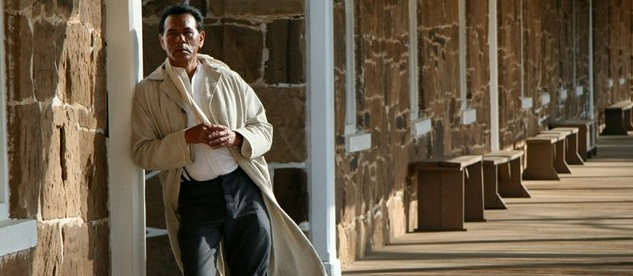'The Only Good Indian' fits well with captivity narrative, revisionist Western films

LAWRENCE — In University of Kansas Film and Media Studies Professor Kevin Willmott's 2009 film, "The Only Good Indian," a young Kickapoo boy is forcibly taken from his parents in the early 1900s and enrolled in a federal boarding school, Haskell Institute in Lawrence.
The boy, Nachwihiata, is renamed Charlie and forced to speak the English language, though he runs away with a copy of Bram Stoker's "Dracula. This is one instance of the film turning tools of forced captivity and assimilation on its head, as Nachwihiata and later the Cherokee county hunter Sam Franklin, played by Wes Studi, are able to triumph over the white villains.
 "The film makes horribly immediate the physical and cultural violence suffered by 19th century American Indians," said Laura Mielke, KU associate professor of English. "It also includes a narrative of how this Kickapoo boy who is forced to go to boarding school uses the Western literature and the English language and those forces of colonialism against it."
"The film makes horribly immediate the physical and cultural violence suffered by 19th century American Indians," said Laura Mielke, KU associate professor of English. "It also includes a narrative of how this Kickapoo boy who is forced to go to boarding school uses the Western literature and the English language and those forces of colonialism against it."
Her new essay, "Transforming Captivity Narratives in Kevin Willmott's 'The Only Good Indian,'" appears in the journal American Studies, which is edited at KU by professors Sherrie Tucker and Randal Maurice Jelks. Mielke's analysis stemmed from a 2009 KU undergraduate honors English course she taught on Captivity Narratives.
Under Willmott's direction and with the screenplay by Thomas Carmody, the film premiered at the Sundance Film Festival in 2009 and was awarded honors at the American Indian Film Festival that year.
"The film unites a critique of the boarding school's linguistic colonialism with a self-reflexive meditation on how narratives arising from the context of captivity are transformed by the captive from the tool that binds to the weapon that liberates," Mielke wrote in the article.
It fits in well with a group of a revisionist Western films that resist the genre’s "black and white" and "good versus evil" narratives. Another recent popular film that followed this path was Quentin Tarantino's 2012 "Django Unchained," a spaghetti Western about a man emancipated from slavery who joins a bounty hunter to track down the South's most-wanted criminals and liberate his wife.
"The whole group now of revisionist Westerns play with race and gender and violence and imperialism," Mielke said. "Instead of simply rejecting the traditional Western for all of its problematic narratives of savage versus civilization and winning the West, they take all of its trappings and tell different stories."
"The Only Good Indian" and others in this genre explicitly tie the evolution of the captivity narrative — especially across genres and between cultures —to the joined acts of reclaiming repressed histories and appropriating more dominant narratives.
"You break stereotypes and you bring to the fore the historical violence that was never depicted in traditional Westerns," she said.
As part of her essay, Mielke interviewed Willmott and Carmody, who mentioned conversations at screenings and receiving emails from viewers with relatives who attended American Indian boarding schools.
"The boarding school legacy, unlike the remains of 'Dracula,' will never simply vanish," Mielke wrote, "because a stake through the heart does not disappear a stereotype or the warfare and institutionalization linked to it. But works that challenge the dominant portrait of white captivity in America prompt more narratives, revisions and unshackling of the past."
Photo: A scene from Professor Kevin Willmott's "The Only Good Indian," which premiered in 2009.